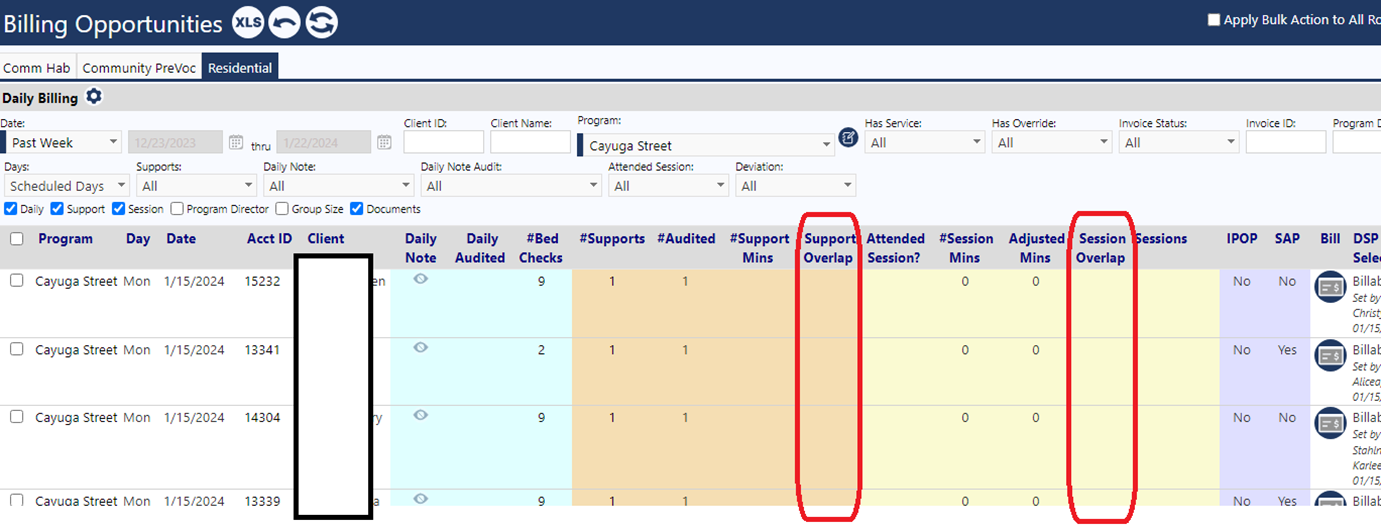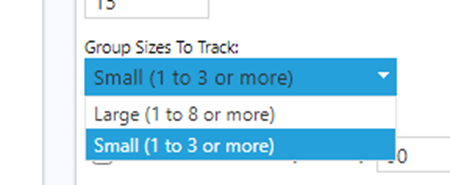When trying to understand Billing Rules, your best bet to understand and validate these Billing Rules is to create multiple fictitious test cases that illustrate the rules. That’s why the ‘rule tester’ button has been added. It could be a bit tedious and you need to be a bit creative to set up some of them, but that’s really the only way to tell if the rules produce the desired result, because there are many possible combinations of supports, session times, and group sizes that a person may have.
Support Overlaps
Viewing the billing opportunities screen below, you will see a column in red for support overlaps.
For programs where the support start and end time for the supports you are performing are collected, we know the start and end of each support. If the time interval for one of the supports you provider overlaps with the time interval of another support for the same person, then you will see a “Y” in the support overlap column (for “Yes”).
Example: I did cooking assistance with “Billy” from 5pm to 6pm. I also did reading with Billy from 5:30pm to 6:30pm. That is an overlap. In some cases, it may be okay and in some cases it may not. That is why we give you the rule to check if you care about overlaps or not.
(An acceptable overlap may be that when doing cooking, Billy had to read the recipe so that counted as a reading support at the same time. An example of an unacceptable overlap is Billy was doing cooking from 5-6 and was marked as attending a community event from 5:30-6:30).
If you select the rule “No Supports overlaps” for a billable service, then if there are overlaps (i.e. that columns says “Y”), the rules engine will not pick that service because the rules have not been met. Note that if the system reports an overlap, you can always click on the supports count and get a popup of all the supports that were performed and the times.
If the end time is not being collected (like for residential where you do not collect end time), support overlaps are never going to happen so the rule becomes meaningless.

Session Overlaps
Session overlaps works in a similar way as the Support Overlaps. When you look at the billing opportunities screen abovew, you will see a column in red for session overlaps.
For programs where you sessions are used, attendance is taken so you know the start and end of each time period the person attended that session. If one of the time periods the person attended overlaps with another time period of attendance for the same person, then you will see a “Y” in the session overlap column (for “Yes”).
Example: You have a DayHab program with a morning session. When taking attendance, you said that “Billy” arrived at 8:00 and departed at 11:00. However, the CommHab program also has a session and for that one, staff said that “Billy” arrived at 10:00 and was there until 2pm. Those two periods of attendance overlap. We know that Billy could not have been at DayHab from 8-11 and at the same time been at CommHab from 10-2pm. So, someone made a mistake.
If you select the rule “No Session overlaps” for a billable service, then if there are overlaps (i.e. that columns says “Y”), the rules engine will not pick that service because the rules have not been met.
Group Size
The rules for group size are:


Group size 1 is one person, in other words a one-on-one activity.
Group size 2 is a one-on-two activity, one staff and two clients.
Group size 1 and/or 2 is total minutes for any one-on-one activities and one-on-two activities added together (a common need per Denise)
Any Group size is the sum of all supports for Group size 1, 2, 3, … N (where N is whatever group size you logged).
Group Size to Track
- For some programs the maximum group size is considered to be 3 and for other programs it is 8.
The maximum group size for a particular program is set for that program on the program setup screen:

For example, let’s say I had 3 different charge possibilities for CommHab:
- “Personal- $100” – the rule may be 3 supports of Group Size 1
- “Mostly Personal- $80” – the rule may be 3 supports of Group Size 1 and/or 2
- “Not Personal - $40” – the rule may be 3 supports of any group size
Now, let’s assume I did 3 supports for “Billy”.
-
The rules would first check to see if we met the criteria for “Personal”. If we had 3 one-on-one supports we’d meet the criteria and get $100.
-
If not, it would check “Mostly Personal” to see if we got to 3 supports if we counted both one-on-one and one-on-two.
-
And so on.
Setup
When setting up/editing the Billing Rules, when you select the #Supports with any Group Size, Group Size 1, or Group Size 1 and/or 2, you need to enter the number of supports in the value field. If the rule is that to get paid for Billy, Billy needs to have received 3 supports for the day then you’d enter a 3. If it was 5 supports for the day, you’d enter a 5, etc.
The rules apply to one billable event, i.e. one row on the billing opportunities screen. So, these are the rules to get paid for “Billy” for the day (or month). i.e. One person – one billable event. If he needs 3 supports to get paid for the day – then enter a 3. If one support is sufficient to get paid, then enter a 1. If to get paid I need one support with any size group, then choose the rule “any size group” and enter a 1 in the box.
You may come across regulations that require you to do billing in a certain way. For example, in a regulation for billing for OPWDD SEMP, Community PREVOC is based on adding the amount of time together for the day, then rounding the time for anything between 10-14 minutes up to 15 minutes. The rules for support minutes, sums up the minutes for each of the supports and then rounds the total up to the nearest 15 minutes. So, if I did “cooking” with “Billy” from 5:00 to 5:30, and then reading from “8:00 to 8:20” that is 50 minutes. Rounded up to the nearest 15 minutes would give us 60 minutes, or four 15-minute units for the day. This of course depends on having a start and end time for each support. You’ll want to create some test cases to try it out.
The group size billing rules (has minutes with group size 1 / size 1 and or 2 / any group size) all behave like that. They’ll sum up all the time for all supports that fit their criteria, and bill the number of times equal to how many 15 minute intervals they fit into, rounded up. Like the example in the previous email, 50 minutes of supports would round up to 60, which is 4 billable units, so the service would be billed for 4 times. The only special case is if the total minutes is under 15 – as long as you have at least 10 minutes, it’ll round up to 15. If you have less than 10 minutes, nothing will be billed for.
